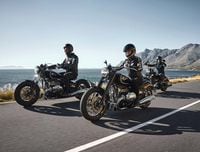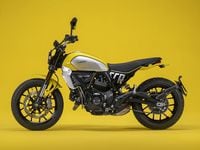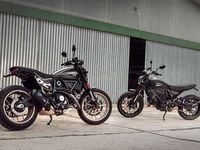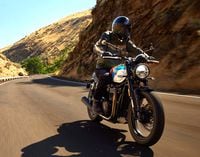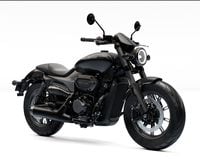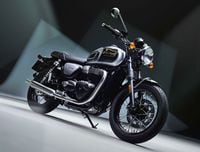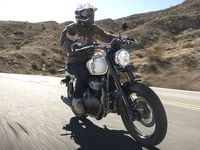Pilots talk about "getting behind the airplane." It refers to a situation where the pilot fails to anticipate and prepare to execute the next three to five tasks that need to be handled to make the flight continue smoothly and safely. This may include items that may not need to be dealt with for half an hour or more. In motorcycling, the next three to five things that need to be addressed to avoid disaster may occur in as many seconds. In most cases, executing the responses to situations is easy, but it takes experience and training to anticipate what is about to happen, what threats are likely to arise.
Some threats may be quite predictable. I am about to run out of gas from my main tank, so I will switch to reserve now to avoid slowing when it happens. The sun is going over the hills, so I'll pull over soon and change to an untinted shield. The turn ahead has that slippery patch in it; I'll slow and adjust my line to avoid it.
However, most of the big threats are not so predictable. A driver makes a left turn in front of you as you approach. A car changes lanes into your space to avoid something you can't see on the road ahead. There is sand scattered across your lane in a blind corner. A deer jumps out into the road ahead.
But even if you can't predict precisely what is going to happen as you ride through the world, you can anticipate what could happen, weighting each with various degrees of likelihood. If you ride in the city frequently, you quickly learn not to rush into a major intersection where the light has just turned green at 8:17 a.m., because cross traffic that is late for work may try to beat the red light. If you ride on a winding country road regularly, an attentive rider can quickly see signs that a certain closing-radius turn frequently shows skid marks that cross the center line, which should make you very cautious about it as you approach it going the other way. On the other hand, you can be fairly sure that oncoming traffic won't swerve across a 50-yard-wide divider on a multi-lane highway, so you need not devote too much attention to that possibility.
What We Know
Preparing for threats involves a combination of experience and imagination. As you gain more experience, your threat awareness and reaction become more ingrained and automatic. However, new riders can fill in the experience deficit with an attitude built around four pieces of fairly solid information:
1) Other drivers can't see me.
2) Other drivers don't like me.
3) It's official: I'm the only one left in this state who knows how to drive.
4) Something is going to go wrong.
Okay, so those first three statements aren't totally true, but if you behave as though they are, you'll avoid many unwanted thrills. You will also discover that things often unfold as if they those axioms are true. With those four canons of life on the street programmed into your threat computer, you can start playing the What-If game. What if that driver up ahead turns left in front of me? What if there is a deer behind that roadside bush? What if there is something in this turn coming up? What if cross traffic blows its stop sign at the intersection up ahead? What if the truck ahead throws a retread? What if this SUV decides to change lanes as I pass through its blind spot? What if the mechanic didn't tighten the oil drain plug on the car ahead? What if I pick up a nail on this busy freeway ramp? What if this driver juggling a cell phone, coffee and a cigarette overloads and freaks out? What if some of the junk on the back of this truck falls off? What if one of the cars parked on this hill doesn't have the brake set? What if the car next to me swerves unexpectedly? What if blue ice falls off the airplanes crossing the road ahead on approach to land?
Obviously, some of these possibilities are more likely than others. If you are in heavy traffic, the antics of drivers become more credible problems. If you are out in the middle of nowhere with no vehicles in sight, the flat tire or deer are bigger threats. Common sense and experience help you prioritize them.
Accepting the final rule of the rough-and-tumble road ("Something will go wrong") will help you in many ways. It will put you in a frame of mind to stay alert and ready for whatever it is that going to happen. It will make you see to it that your bike is in peak mechanical condition. And it will make you don the protective gear that can make the difference between life and death or animal and vegetable.
Out in Front
The vast majority of the threats a motorcyclist encounters come from ahead of him. Therefore most of your time should be spent scanning ahead of you. If half your time is normally spent examining your mirrors, you either live where tailgaters are even more rabid than in Southern California or you need to readjust your threat seekers.
Urban traffic is the most demanding arena. It is not enough to simply keep an eye on the vehicle immediately ahead and the ones next to you, you must scan well ahead of them. The events taking place a block or more ahead will determine what is going to happen where you are. For example, a car stops and makes an awkward play for a parking place, which immediately brings traffic in the right lane -- the lane next to you -- to a halt. Since you have a good view up the road, thanks to your lane position and elevated line of sight, and have been scanning ahead, you see this developing. You have also been paying attention to the driver ahead and to your right and know he has been distracted by his cell phone and probably isn't aware that traffic in front of him is about to get on the brakes hard. Your lane is overtaking his at a rate that will put you in his blind spot about the time he gets the news, and you can guess that he will try to change lanes rather than stop. With that awareness, you can close up on the car in front of you to move out of the blind spot (though the driver ahead might get on the brakes too if another car ahead jumps from the right lane) or back out of the space next to the unaware driver's car or take some other avoiding action, such as moving to a lane farther left.
Intersections are consistent danger zones. The light changes to green for you as you arrive at an intersection. You see a crossing car that looks like it is going to try to make it even as cars on your street begin rolling. Your likeliest avoidance maneuver is to simply brake and make sure he stops or let him go through, although this involves the chance that swerving or bouncing cars or an inattentive driver behind you might tag you. You might also use a large vehicle (armored cars are good) to run interference for you by passing through the intersection with the large vehicle between you are the red-light-runner.
Sometimes the danger may be as simple as the inability to see completely. A large vehicle, either parked or in traffic, may block your view, or a curve, building or vegetation may impede vision both for you and cross traffic. A vivid imagination can warn you about what might be waiting in there for you. I was riding with a group of riders one day on a country road, which was punctuated by an occasional short, steep hill. We were motoring along pretty good, but as we approached each hill, I'd slow down and others would pass me. Eventually I was second-to-last in the group, which I'd started out leading. I asked the only rider behind me why he hadn't passed too. "Hey, I'm with you," he laughed. "I just can't bring myself to charge over some hill when I can't see what's over the crest."
Even though you can see a car waiting to pull out or turn out, you can't be sure if the driver sees you. You can counter such a situation by positioning yourself to be as visible as possible, and by dressing conspicuously. There is a hidden driveway on one of my routes home that once in perhaps 200 times I pass it produces a car that pulls out in front of me. Even though that means it happens once every couple of years, I pass it riding at the very left side (where the driver has a better chance of noticing me and I have more time and distance to react before we have a conflict) and ready to react.
Certain situations can be very complex. Factors that distract drivers or cause them to change their pattern can arise simultaneously from more than one place, and you must try to anticipate how they might interact. I was following two SUVs one day on a street that had three lanes going our direction. One was in the right lane, one in the left. I was behind them in the middle and overtaking as we approached an intersection. The left-turn lane was jammed to overflowing, and the last car was partially blocking the left lane. A car was turning into a parking lot on the right, but was getting on his brakes, apparently to let some pedestrians pass. At my rate of travel I would have passed between the two SUVs, which were side-by-side just before we reached the intersection, but it seemed like at least one of them was likely to change to the middle lane about the time I got there, so I slowed down. Sure enough. They might have seen each other, but just as they reached the point where they had to move over or brake hard, they were distracted by another event ahead in the intersection, where a major squealing and honking suddenly arose. It looked like both drivers looked toward the commotion instead of where they were going, which turned out to be the same placethe middle lane. Neither signaled, and they swerved as though synchronized. They clipped each other. I probably could have avoided getting caught up in all that even if I had been between them, but it was much more fun to hang back and watch than try to escape.
When It Happens
Your speed bears on how well you perform when a threat arises. The faster you are approaching the threat, the less time you have to recognize it, anticipate what will happen and take appropriate action. And, whether you swerve, brake, or simply pray, it will consume more distance than if you were going slower. In other words, when things go wrong, speed is not likely to be your friend (though I have certainly had moments when going slower would have let me avoid getting caught up in something that my speed let me avoid.)
Anticipating correctly is not enough. You must also have a plan in place to react to the threat you predicted when it develops. If I had been between the two SUVs mentioned above, I would have been in a lower gear with the brakes (and horn) covered, prepared to either brake hard or accelerate away, depending on exactly where I was when it happened. Other situations might call for you to move across your lane away from the potential threat, to slow, to speed up, to try to attract attention (flash your headlight or honk), to prepare to swerve hard, or to line up on a potential escape route.
Although a new rider will have to train him or herself to anticipate and prepare a strategy for unraveling situations, it will become more and more automatic with experience, particularly for those who ride daily. You can also practice all those escape strategies—braking, swerving hard, positioning yourself away from threats, no matter how unlikely they seem, and following the holes in traffic ahead (which also usually gives a better view up the road).
Most of this anticipation-preparation-evasion will just be dry runs. But if doing it becomes ingrained, it can make what could be nasty events turn out about as exciting as another dry run. When that happens, congratulate yourself and reinforce yourself for your diligence and wisdom.
Some Call it SIPDE
The Motorcycle Safety Foundation has developed an acronym for the mental process required to anticipate and deal with threats. It's SIPDE (pronounced sip-dee), and it stands for:
Scan: Actively search for hazards from traffic, the roadway and the environment.
Identify: Determine which of the items you see constitute actual or potential hazards.
Predict: Determine what the hazard is likely to do or how it might affect you and how serious it is.
Decide: Determine a course of action based on your observations and anticipation of what the hazard might do.
Execute: Carry out your plan. Slow or stop, swerve, honk, accelerate and/or move away from the threat.
_Ask Friedman what his headlight does when he flashes it at _ ArtoftheMotorcycle@hotmail.com.
_For more information on safe-riding equipment, strategies, techniques and skills, see the _ Street Survival section of MotorcycleCruiser.com.










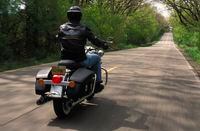
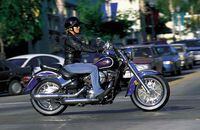
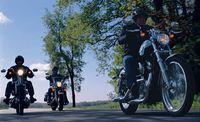
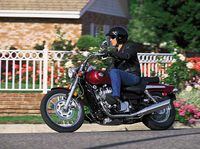
/cloudfront-us-east-1.images.arcpublishing.com/octane/H6Z2IC7WYRBXZNQS4MI3SZ5KPQ.jpg)
/cloudfront-us-east-1.images.arcpublishing.com/octane/IWO5T5PBT5E4HFQ5GK47H5YXR4.jpg)
/cloudfront-us-east-1.images.arcpublishing.com/octane/OQVCJOABCFC5NBEF2KIGRCV3XA.jpg)
/cloudfront-us-east-1.images.arcpublishing.com/octane/F3O2DGLA4ZBDJGNVV6T2IUTWK4.jpg)
/cloudfront-us-east-1.images.arcpublishing.com/octane/ZXYQE3MHLFDSPKNGWL7ER5WJ4U.jpg)
/cloudfront-us-east-1.images.arcpublishing.com/octane/RDF24VM7WVCOBPIR3V3R4KS63U.jpg)
/cloudfront-us-east-1.images.arcpublishing.com/octane/W7RSIBFISNHJLIJESSWTEBTZRQ.jpg)
/cloudfront-us-east-1.images.arcpublishing.com/octane/AERA26ENRNBW3K324YWCPEXYKM.jpg)
/cloudfront-us-east-1.images.arcpublishing.com/octane/YWX3YX7QBBHFXFDMEEEKRG4XJE.jpg)
/cloudfront-us-east-1.images.arcpublishing.com/octane/I7OKI53SZNDOBD2QPXV5VW4AR4.jpg)
/cloudfront-us-east-1.images.arcpublishing.com/octane/IH52EK3ZYZEDRD3HI3QAYOQOQY.jpg)
/cloudfront-us-east-1.images.arcpublishing.com/octane/K2FSAN7OWNAXRJBY32DMVINA44.jpg)
/cloudfront-us-east-1.images.arcpublishing.com/octane/G4XK7JL24FCUTKLZWUFVXOSOGE.jpg)
/cloudfront-us-east-1.images.arcpublishing.com/octane/JJNXVAC27ZCDDCMTHTQZTHO55Y.jpg)
